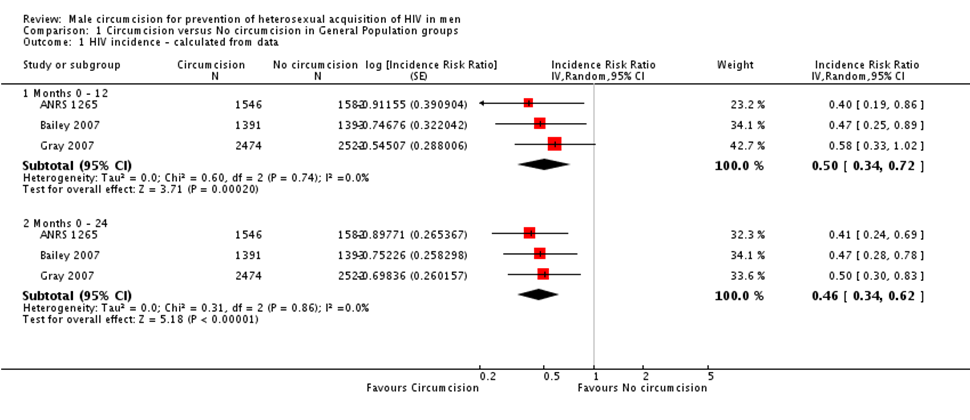Male circumcision for prevention of heterosexual acquisition of HIV in men.
Male circumcision reduces HIV acquisition in heterosexual men by at least 38% in a two year period.
Executive Summary
Background
Observational studies since the 1980s have suggested a protective effect of male circumcision on HIV acquisition in men,but could be confounded.
Inclusion criteria
Studies: Randomized controlled trials
Participants: Sexually active HIV-negative heterosexual men.
Intervention: Male circumcision (surgical removal of the foreskin of the penis).
Outcomes:
Primary outcome: HIV infection in men (incidence),based on laboratory results.
Secondary outcome: behavioural outcomes, including sexual activity.
Results
- Three large trials of men from the general population were conducted in in South Africa (N=3274), Uganda (N=4996) and Kenya (N=2784) between 2002 and 2006. All three trials were stopped early due to significant findings at interim analyses. Allocation concealment was inadequate in two trials and unclear in one; risk of bias was judged to be low to moderate across the three trials.
- There was a relative risk reduction of acquiring HIV of 50% at 12 months and 54% at 21 or 24 months following circumcision. There was little statistical heterogeneity between the trials’results.
- The Kenyan and Ugandan trials showed no significant difference in sexual behaviour between circumcised and uncircumcised men. In the South African trial,the mean number of sexual contacts at the 12 month visit was 5.9 in the circumcision group versus 5 in the control group,which was a statistically significant difference.
- There were few adverse events following the surgical circumcision procedure in all three trials.

Authors’ conclusions
Medical male circumcision is a safe procedure and it reduces HIV infection in heterosexual men by at least 38%
and perhaps up to 66% over 24 months.
Implications for practice:
Male circumcision should be implemented as part of current prevention measures if considered feasible,and socially and culturally acceptable for local conditions.
Implications for research:
Research on the effectiveness of male circumcision for preventing HIV acquisition in heterosexual men is complete and no further trials are required. Future research must focus on the effects of male circumcision on the women partners of HIV- infected circumcised men,on the feasibility of implementing the procedure into different social and cultural contexts,and its cost-effectiveness, as well as its effects on HIV transmission during anal intercourse,both in men who have sex with men and between men and women.
See the full review on the Cochrane Library:
Siegfried N, Muller M, Deeks JJ, Volmink J. Male circumcision for prevention of heterosexual acquisition of HIV in men. Cochrane Database of Systematic Reviews 2009, Issue 2. Art. No.: CD003362.
To read the full review please follow this link: DOI: 10.1002/14651858.CD003362.pub2.
